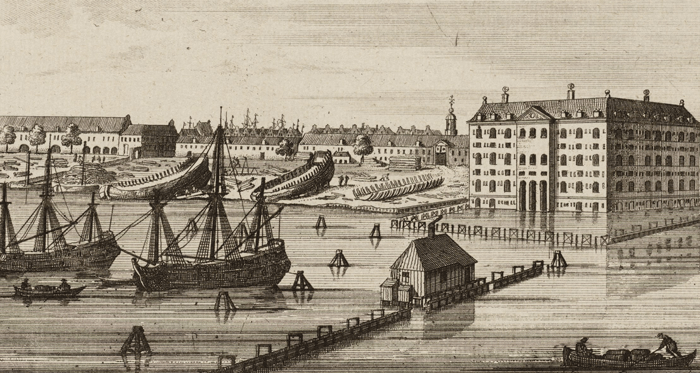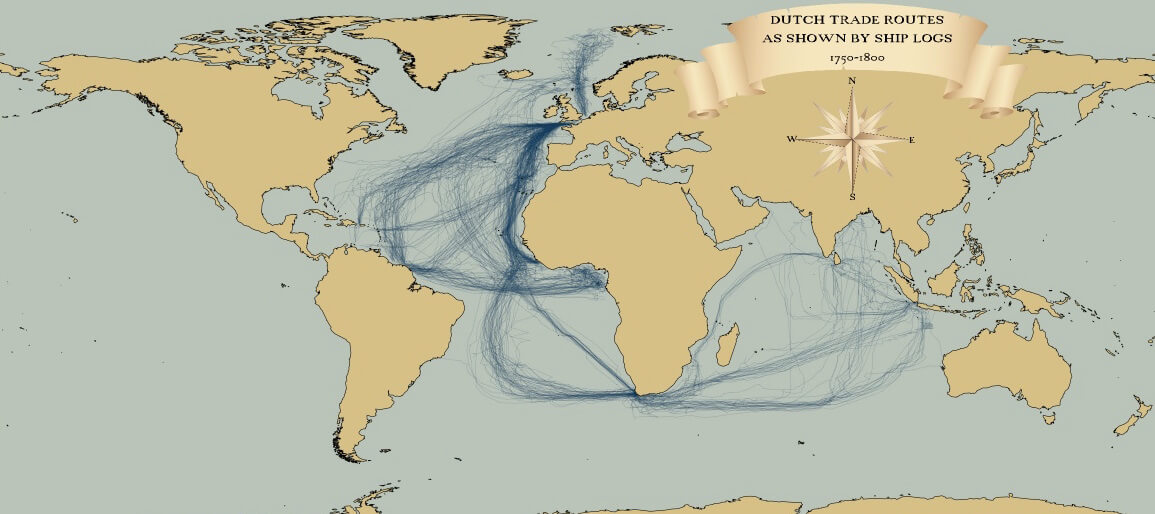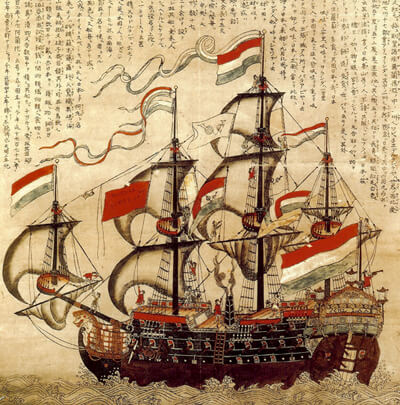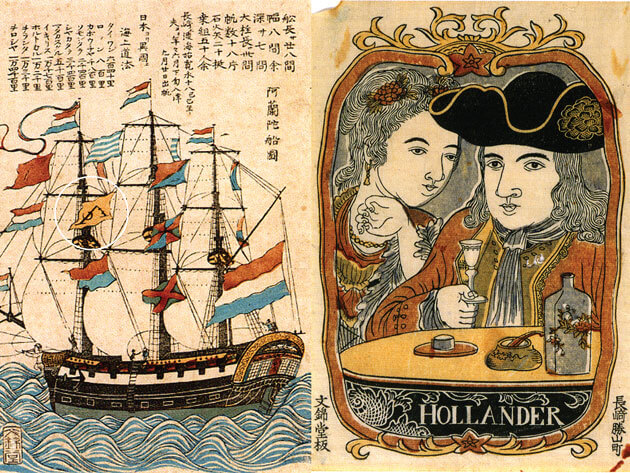
VOC and the Asian Trading Routes
The Dutch East India Company, or the VOC for short (Verenigde Oost Indische Compagnie) was established by charter in 1602. The VOC was first organized to profit from the East Asian spice trade in which the Portuguese already had a stronghold. During the 16th century, the Portuguese established a wide network with settlements in Sri Lanka, India and China, and the Dutch simply purchased the spices from Portuguese traders. After the Spanish occupation of Portugal in 1580, and especially after the fall of Antwerp in 1585, where the spice-traders sold their goods, the Dutch sought out methods to procure their desired commodities. The VOC quickly built a monopoly over international trade, responsible for the transportation of millions of goods between Europe and Asia during its almost two hundred year existence.
 The VOC was organized into six Chambers with representatives in the central board, Heren XVII: Amsterdam, Hoorn, Enkhuizen, Delft, Rotterdam and Zeeland based in Middelburg. Fleets would typically depart in December or January, the so-called Kerstvloot (Christmas fleet), and arrive in Batavia, now Jakarta in Indonesia by June or July. To prepare for the long and arduous journey ahead, VOC ships would gather at the shores of Texel, where they took in fossil water rich in iron from wells that would not spoil as quickly as regular water. When the English Channel was safe from war and piracy, some ships from the southern Chambers of Delft, Rotterdam and Zeeland joined the fleet from the harbours of Goeree and Rammekens, but otherwise the gathered fleet idled in the moorage of Texel until the winds shifted in the right direction before setting sail around Scotland. Around 1617, a shorter round-trip route was discovered, reducing travel time from a year to six months depending on the wind.[1]
The VOC was organized into six Chambers with representatives in the central board, Heren XVII: Amsterdam, Hoorn, Enkhuizen, Delft, Rotterdam and Zeeland based in Middelburg. Fleets would typically depart in December or January, the so-called Kerstvloot (Christmas fleet), and arrive in Batavia, now Jakarta in Indonesia by June or July. To prepare for the long and arduous journey ahead, VOC ships would gather at the shores of Texel, where they took in fossil water rich in iron from wells that would not spoil as quickly as regular water. When the English Channel was safe from war and piracy, some ships from the southern Chambers of Delft, Rotterdam and Zeeland joined the fleet from the harbours of Goeree and Rammekens, but otherwise the gathered fleet idled in the moorage of Texel until the winds shifted in the right direction before setting sail around Scotland. Around 1617, a shorter round-trip route was discovered, reducing travel time from a year to six months depending on the wind.[1]
The Cape of Good Hope was the first stop on the long journey. Stock was replenished, water refreshed and the sick were offloaded. If necessary or possible, new sailers boarded, as did travelers and officials traveling to the East. When the winds were still good, the ships sailed on to the Far East, some making an additional stop at Galle, Sri Lanka, where the best cinnamon could be had.[2]
During the 17th century and 18th centuries, VOC ships transported passengers in addition to goods. People traveled to the colonies to visit family and friends, or back to The Netherlands to seek better education, or to find a suitable lover. Many passengers simply wanted to start a new life in the colonies of the Cape of Good Hope or Batavia. The regular ship traffic informed colonists of current events in their homeland through word of mouth, journals, newspapers and letters.
 During the first half of the 17th century, the VOC overtook all major shipping routes and settlements from the Portuguese.[3] The Dutch managed to obtain an extensive inter-regional trading network in the Indian Ocean, South China Sea and the Philippine Sea until about 1800. At that time, the organization had grown to such an extent, that it collapsed under its own weight by corruption, contraband trade and theft by its own officials. Moreover, the new fashions no longer dictated exotics from the Far East, but creamware from the United Kingdom, porcelain from Germany and silks from France. Further, the war with England (the fourth war 1780-1784) and the French occupation of The Netherlands complicated the situation; to prevent the French from overtaking the Dutch colonies, the British took hold of all Dutch settlements in the Far East, except for Japan.[4]
During the first half of the 17th century, the VOC overtook all major shipping routes and settlements from the Portuguese.[3] The Dutch managed to obtain an extensive inter-regional trading network in the Indian Ocean, South China Sea and the Philippine Sea until about 1800. At that time, the organization had grown to such an extent, that it collapsed under its own weight by corruption, contraband trade and theft by its own officials. Moreover, the new fashions no longer dictated exotics from the Far East, but creamware from the United Kingdom, porcelain from Germany and silks from France. Further, the war with England (the fourth war 1780-1784) and the French occupation of The Netherlands complicated the situation; to prevent the French from overtaking the Dutch colonies, the British took hold of all Dutch settlements in the Far East, except for Japan.[4]
Interregional Trade
When the VOC fleets reached Batavia, the center of the Dutch trade, they either traded goods and made the return passage, or continued to travel throughout the Far East. Within Asia, the ships served for either a few months up to several years before returning to their homeland.[5] Subject to ritme of the monsoons, the ships sailed from Batavia in a fan-shaped plan to destinations as Indonesia, India, China, Japan but also Jemen and Persia, where commodities were traded back and forth with great profit. VOC fleets carried a cargo of silver to pay for their desired goods in the various ports.
Spices were well sought after and expensive throughout Europe, Arabian territories, and even in the Far Eastern countries in which they were mostly obtained. Nutmeg, cloves, cinnamon, and pepper were used primarily to flavor and preserve foods. They also had medicinal properties and were used in cosmetics. The spices could not be obtained directly in Indonesia, as the clan chiefs were uninterested in silver. They were, however, willing to trade for the highly valued colorful floral fabrics from India called chintzes that the Dutch eventually secured later in the journey.
The first stop on the Asian trading route was Macau, one of China’s largest ports. In China, silver was traded for woven silks and loose threads that earned great profit on the European silk market. The Dutch also traded for the coveted Chinese porcelain and tea. These commodities obtained in China were also in high demand in Japan, where they were traded against copper bars. Once the fleet arrived in India, VOC officials obtained the colorful chintzes in exchange for copper, a material commonly used in temple roofs and cooking utensils.
The VOC made a final stop in Batavia on the return fleet, loaded with floral chintzes and rough Chinese earthenware storage jars for the Indonesian market. Finally, the fleet attained the profitable spices of pepper, cloves, nutmeg, anise and cinnamon that were auctioned in the fall.[6] By July, ships were safely back in the harbors of Texel and Amsterdam (only the ships of the Chamber of Zeeland went straight to the docks of Middelburg).
Other Treasures
VOC ships not only returned with spices, but a variety of precious exotics that previously reached Europe through the traditional Silk Route from East China across Central Asia to the Middle East and Mediterranean Sea. These commodities could now be distributed in larger quantities through the VOC.
The most obvious and important exotic was Chinese and Japanese porcelain, the source of inspiration for the Delft potters and painters. Other commodities such as silk and silk threads were shipped, as were luxury items of chintz, musk, diamonds, rubies, pearls, umbrellas, carpets, incense and highly praised Japanese lacquerware. Coffee and tea were imported, as were exotic plants, fruits and animals. Specific types of wood were brought home, either to be scraped as a textile-dye or to be used in carpentry, as were for example Brazil wood and ebony.
 The ships also brought the commodities to settlements in South Africa, India and East Asia where they could not be acquired locally. Limestone, marble or European oak served as a weight to keep the ships steady during the trip and were used as building materials in the colonies. Typical Dutch foods such as salted butter, cheese, jenever, and salted herring were greatly missed, as were objects that were needed to maintain a certain standard of living: wigs, glasses, silk stockings, stays for ladies garments, shoes, linen and wool fabrics, and lace. The colonies also received more ordinary items of nails and tools, seeds for crops, and furniture. Other importations to the colonies included glass bottles for the South African wine industry, medicinal products, dyes, paint, ink, (seal) wax and paper.[7] Although Delftware was not a common Dutch export, many of the food shipments to the colonies were likely packaged in simple white Delftware containers. The Witte Ster (White Star) factory is known to have supplied the ships of the Chamber of Delft with Delftware items, when the factory was in charge of Albertus Kiell from 1762 until 1774.[8] These everyday items, rare to survive, probably still exist in their country of importation. Although not many Delftware objects are known in Asian museum collections, they still might turn up in the future!
The ships also brought the commodities to settlements in South Africa, India and East Asia where they could not be acquired locally. Limestone, marble or European oak served as a weight to keep the ships steady during the trip and were used as building materials in the colonies. Typical Dutch foods such as salted butter, cheese, jenever, and salted herring were greatly missed, as were objects that were needed to maintain a certain standard of living: wigs, glasses, silk stockings, stays for ladies garments, shoes, linen and wool fabrics, and lace. The colonies also received more ordinary items of nails and tools, seeds for crops, and furniture. Other importations to the colonies included glass bottles for the South African wine industry, medicinal products, dyes, paint, ink, (seal) wax and paper.[7] Although Delftware was not a common Dutch export, many of the food shipments to the colonies were likely packaged in simple white Delftware containers. The Witte Ster (White Star) factory is known to have supplied the ships of the Chamber of Delft with Delftware items, when the factory was in charge of Albertus Kiell from 1762 until 1774.[8] These everyday items, rare to survive, probably still exist in their country of importation. Although not many Delftware objects are known in Asian museum collections, they still might turn up in the future!
Notes
[1] E. Hartkamp-Jonxis, Sits, Oost-West relaties in Textiel, Zwolle, 1987, p.15
[2] E.M. Jacobs, Koopman in Azië, De handel van de Verenigde Oost-Indische Compagnie tijdens de 18e eeuw, Zutphen, 2000, p. 39
[3] Hartkamp-Jonxis 1987 (note 1), pp.12-13.
[4] Jacobs 2000 (note 2), pp.15-16.
[5] Idem, p. 14.
[6] Hartkamp-Jonxis 1987 (note 1), pp.19-20.
[7] Inventories of the Masters of Orphanage Chamber of Cape Town, South Africa.
[8] E. Bergvelt, M. Jonker, A. Wiechmann a.o., Schatten in Delft: Burgers verzamelen 1600-1750, Stedelijk Museum Prinsenhof Delft, Zwolle, 2002, p. 44.
